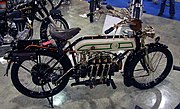 Motorcycle Before World War II, In The 20th century A 1913 FN (Fabrique National), Belgium, 4cylinders and shaft drive
Motorcycle Before World War II, In The 20th century A 1913 FN (Fabrique National), Belgium, 4cylinders and shaft driveIn 1898, English bicycle maker Triumph decided to extend its focus to include motorcycles, and by 1902, the company had produced its first motorcycle—a bicycle fitted with a Belgian-built engine. In 1903, as Triumph's motorcycle sales topped 500, the American company Harley-Davidson started producing motorcycles.
In 1904, the Indian Motorcycle Manufacturing Company, which had been founded by two former bicycle racers, designed the so-called "diamond framed" Indian Single, whose engine was built by the Aurora Firm in Illinois. The Single was made available in the deep red color that would become Indian's trademark. By then, Indian's production was up to over 500 bikes annually and would rise to 32,000, its best ever, in 1913.
During this period, experimentation and innovation were driven by the popular new sport of motorcycle racing, with its powerful incentive to produce tough, fast, reliable machines. These enhancements quickly found their way to the public’s machines.
A 1923 BMW R32, with a shift-drive, boxer twin engine
 Chief August Vollmer of the Berkeley, California Police Department is credited with organizing the first official Police Motorcycle Patrol in the United States in 1911. By 1914, motorcycles were no longer just bicycles with engines; they had their own technologies, although many still maintained bicycle elements, like the seats and suspension.
Chief August Vollmer of the Berkeley, California Police Department is credited with organizing the first official Police Motorcycle Patrol in the United States in 1911. By 1914, motorcycles were no longer just bicycles with engines; they had their own technologies, although many still maintained bicycle elements, like the seats and suspension.A pre-war Polish Sokół 1000
An historic V-twin American motorcycle — a 1941 Crocker
 Until the First World War, Indian was the largest motorcycle manufacturer in the world. After that, this honor went to Harley-Davidson, until 1928 when DKW took over as the largest manufacturer. BMW motorcycles came on the scene in 1923 with a shaft drive and an opposed-twin or "boxer" engine enclosed with the transmission in a single aluminum housing.
Until the First World War, Indian was the largest motorcycle manufacturer in the world. After that, this honor went to Harley-Davidson, until 1928 when DKW took over as the largest manufacturer. BMW motorcycles came on the scene in 1923 with a shaft drive and an opposed-twin or "boxer" engine enclosed with the transmission in a single aluminum housing.By 1931, Indian and Harley-Davidson were the only two American manufacturers producing commercial motorcycles. This two-company rivalry in the United States remained until 1953, when the Indian Motorcycle factory in Springfield, Massachusetts closed and Royal Enfield took over the Indian name.
 There were over 80 different makes of motorcycle available in Britain in the 1930s, from the familiar marques like Norton, Triumph and AJS to the completely obscure, with names like New Gerrard, NUT, SOS, Chell and Whitwood, about twice as many motorcycle makes competing in the world market during the early 21st century.
There were over 80 different makes of motorcycle available in Britain in the 1930s, from the familiar marques like Norton, Triumph and AJS to the completely obscure, with names like New Gerrard, NUT, SOS, Chell and Whitwood, about twice as many motorcycle makes competing in the world market during the early 21st century.In 1937, Joe Petrali set a new land speed record of 136.183 mph (219.165 km/h) on a modified Harley-Davidson 61 cubic inch (1,000 cc) overhead valve-driven motorcycle. The same day, Petrali also broke the speed record for 45 cubic inch (737 cc) engine motorcycles.
In Europe, production demands, driven by the buildup to World War II, included motorcycles for military use, and BSA supplied 126,000 M20 motorcycles to the British armed forces, starting in 1937 and continuing until 1950. Royal Enfield also produced motorcycles for the military, including a 125 cc lightweight motorcycle that could be dropped (in a parachute-fitted tube cage) from an aircraft.
sumber:http://en.wikipedia.org

0 comments:
Post a Comment